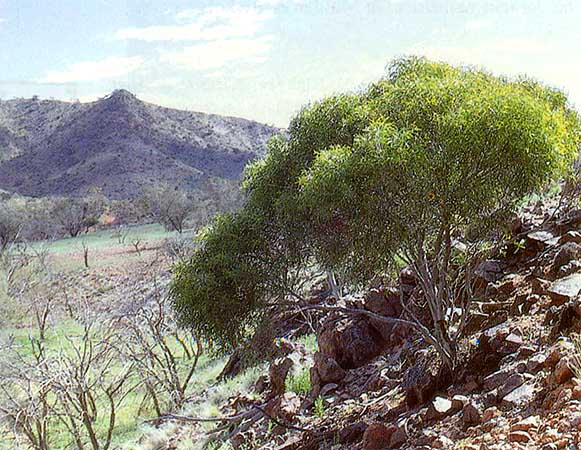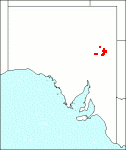Family: Fabaceae
Acacia confluens

Citation:
J. H. Maiden & W. F. Blakely, J. Proc. R. Soc. N.S.W. 60:183 t.16 (1927).
Derivation: confluens (L.)—flowing into; referring to the merging of the main vein with the margin
Synonymy: Racosperma confluens (Maiden & Blakely)Pedley, Bot. J. Linn. Soc.(London) 92:248 (1986).
Common name: wyrilda
Description:
Medium-sized, glabrous shrubs 2-3 m high, usually dividing into a number of obliquely ascending stems from near the base and forming a quite dense umbrella-like spreading canopy; branchlets angular, smooth and reddish-brown; bark greyish, slightly fissured near the base.
Phyllodes obliquely-lanceolate, 7-14 cm long, 5-25 mm broad, falcate, gradually tapering into a long acuminate curved point, 1-major vein eccentric, usually closer to the lower margin with which it is confluent for a short distance at the base, numerous fine reticulate lateral veins which are often obscure due to the scurfy covering on the surface of the phyllodes; glands small but obvious, depressed, situated on the upper margin, 5-10 mm from the base, sometimes a small second gland further along the margin.
Inflorescences axillary and solitary or up to 10 heads in axillary racemes shorter than phyllodes; flower-heads large, pale yellow, 40-60-flowered; peduncles slender, glabrous, 8-15 mm long; flowers 5-merous.
Legumes linear, 10-25 cm long, 10-15 mm broad, straight or curved, coriaceous, thick, surface undulate somewhat rugose and raised over seeds, dark brown, stipitate, apex acute, margins thickened slightly constricted between seeds. Seeds longitudinal in legume, broadly ovoid; funicle slender, in a double fold encircling the seed and thickened into a small white aril.
|
|
Distribution:
|
Endemic to S.Aust., occurring in the northern part of the Flinders Ranges from Mount Lyndhurst eastwards through Arkaroola, Paralana Springs area to the western side of Moolawatana, just into the Lake Eyre region. Associated with tall shrubland on steep stony hillsides and gullies amongst outcropping quartzite. Soils; mainly shallow calcareous loamy. Rainfall approx. 200 mm.
S.Aust.: LE, FR, EA.
|
Flowering time: An irregular and sparsely flowering species, observed flowering m. June, August and September.
|

SA Distribution Map based
on current data relating to
specimens held in the
State Herbarium of South Australia
|
Biology:
No text
Related taxa:
In 1948, J. M. Black made Acacia confluens a synonym of Acacia retinodes and it was not again recognised as a distinct species until recent collections were made by staff of the State Herbarium of S.Aust. in 1968. The main features distinguishing it from Acacia retinodes (sp. 48) are in the legumes which have a thicker texture and are much longer and broader, and also in the shape of the seeds and funicle.
Cultivation:
Not known in cultivation but the dense light-green foliage and growth habit would make this species useful for ornamental plantings in inland areas on well drained soils. Conservation status. Briggs & Leigh (1988) consider this species to be Rare.
Author:
Not yet available
Source:

|

